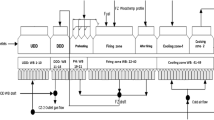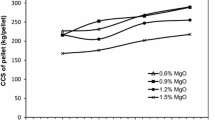Abstract
A laboratory study was carried out to characterize the physical, chemical and mechanical properties of lime fluxed (varying basicity 0–2) hematite iron ore pellets. Lime was used as additive as well as fluxing agent for making iron ore pellets. The effect of additives on different properties of pellets was studied. The findings show that on increasing the addition of lime, more of calcium-alumino-silicate phases were produced as confirmed by SEM-EDAX analysis. These phases have low melting points, which enhances sticking behaviour of pellets, as well as imparts strength to the pellets (resulting increasing compressive strength, tumbler, abrasion and shatter index) but decreases the porosity. The low basicity pellets were found predominantly oxide-bonded, while the high basicity pellets were mostly slag-bonded. This means that the pellet should be fired at sufficiently high enough temperature to generate liquid phases to get the sufficient strength but not so high as to cause the pellets to stick to each other. The obtained properties of these fluxed pellets were compared with the properties of iron ore lump and pellets, which are being used conventionally in the blast furnace for production of iron and steel.







Similar content being viewed by others
References
World Iron Production (2014), http://www.worldsteel.org/statistic/BFI-production.html)
United States Geological Survey, Iron Ore Statistics and Information (Reston, VA, 2014), (available at http://www.minerals.usgs.gov/minerals/pubs/commodity/iron_ore/2013)
United Nations Conference on Trade and Development, The Iron Ore Market 2009–2011 (Geneva, Switzerland, 2010), (available at http://www.unctad.org/infocomm/Iron/Flyer_2010_English.PDF)
Indian Mineral Yearbook, Part-III, edn 51, (2012), (available at http://www.ibm.nic.in/writereaddata/files/07092014125520IMYB_2012_iron%20ore.pdf)
S. Dwarapudi, T.K. Ghosh, A. Shankar, V. Tathavadkar, D. Bhattacharjee, R. Venugopal, Effect of pellet basicity and MgO content on the quality and microstructure of hematite pellets. Int. J. Miner. Process. 99, 43 (2011)
IBM Iron and Steel Vision 2020. Chapter 4; Agglomeration (2012), (available at http://www.ibm.gov.in/ch4.pdf)
M. Onoda, O. Tsuchiya, T. Sugiyama, I. Fujita, Quality improvements of lime fluxed pellets, in Proceedings of ISS-AIME 40th Iron Making Conference, (Toronto, Ontario, 1980), p. 286
S. Dwarapudi, T.K. Ghosh, A. Shankar, V. Tathavadkar, D. Bhattacharjee, R. Venugopal, Effect of pyroxenite flux on the quality and microstructure of hematite pellets. Int. J. Miner. Process. 96, 45 (2010)
T.C. Eisele, S.K. Kawatra, A review of binders in iron ore pelletization. Miner. Process. Extr. Metall. Rev (2003). doi:10.1080/08827500306896
S.P.E. Forsmo, A.J. Apelqvist, B.M.T. Björkman, P.O. Samskog, Binding mechanisms in wet iron ore green pellets with a bentonite binder. Powder Technol. (2006). doi:10.1016/j.powtec.2006.08.008
R.P. de Souza, C.F. de Mendonca, T. Kater, Production of acid iron ore pellet for direct reduction using an organic binder. Mining Eng. Magn. 36, 1437 (1984)
V.M. Chizhikov, R.M. Vainshtein, S.N. Zorin, T.I. Zainetdinov, G.A. Zinyagin, A.A. Shevchenko, Production of iron ore-pellets with an organic binder. Metallurgist 47, 3 (2003)
R.H. Heerema, H. Kortmann, T. Kater, V.C. ven den Boogaard Improvements of acid, olivine and dolomite fluxed iron ore pellets using an organic binder, in 5th International Symposium on Agglomeration, (Brighton, 1989), p. 227
Schmitt J A method for improving the process and quality of iron ore pellets made with organic binders, in 66th Annual University of Minnesota Mining Symposium, Duluth, (2005), p. 19
A. Sarkar, A.K. Mandal, O.P. Sinha, Pelletisation behavior of fluxed iron ore pellets of varying basicities made with waste fines. Int. J. Sci. Eng. 5, 9 (2013)
A.R. Firth, J.F. Garden, J.D. Douglas, Phase equilibria and slag formation in the magnetite core of fluxed iron ore pellets. ISIJ Int. 48, 1485 (2008)
S.C. Panigrahy, B.C. Jena, M. Rigaud, Characterization of bonding and crystalline phases in fluxed pellets using peat moss and bentonite as binders. Metall. Trans. B 21, 463 (1990)
S.C. Panigrahy, P. Verstraeten, J. Dilewijns, Influence of MgO addition on the mineralogy of iron ore sinter. Metall. Trans. B 15, 23 (1984)
F.W. Frazer, H. Westenberger, K.H. Boss, W. Thumm, The relationship between basicity and swelling on reduction of iron-ore pellets. Int. J. Miner. Process. 2, 353–365 (1975)
J.J. Friel, E.S. Erickson, Chemistry, microstructure, and reduction characteristics of dolomite-fluxed magnetite pellets. Metall. Trans. B 11, 233 (1980)
T. Umadevi, P. Kumar, N.F. Lobo, M. Prabhu, P.C. Mahapatra, M. Ranjan, Influence of pellet basicity (CaO/SiO2) on iron ore pellet properties and microstructure. ISIJ Int. 51, 14 (2011)
K.M.K Sinha, T. Sharma, Reduction of iron ore pellets by statistical design of experiments. Int. J. Eng. Res. Sci. Technol. 3, 1 (2014), (available at http://www.ijerst.com/currentissue.php)
ASTM Standard C20-00 Standard test methods for apparent porosity, water absorption, apparent specific gravity, and bulk density of burned refractory brick and shapes by boiling water, ASTM Int., West Conshohocken, (2010). doi:10.1520/C0020-00R10
ASTM Standard C135-96 Standard test method for true specific gravity of refractory materials by water immersion, ASTM Int., West Conshohocken, (2009). doi:10.1520/C0135-96R09E01
ASTM E382-12 Standard test method for determination of crushing strength of iron ore pellets, ASTM Int., West Conshohocken (2012). doi:10.1520/E0382-12
ASTM E279-97 Standard test method for determination of abrasion resistance of iron ore pellets and sinter by the tumbler test, ASTM Int., West Conshohocken (2010). doi:10.1520/E0279-97R10
ASTM D3038-93 Standard test method for drop shatter test for coke, ASTM Int., West Conshohocken (2010). doi:10.1520/D3038-93R10
M. Specht, C. Seaton, A. Morales, Self reduced iron ore pellets using Plexicoke as reductant, in Symposium on Chemistry, Structure and Reactivity of Coals, Tar Sands and Oil Shale, vol. 37 (San Francisco, 1992), p. 608
A. Takashi, F. Kiyoshi, F. Hidekazu, Development of carbon iron composite process, JFE Technical Report 13, 20 (2009) (available at http://www.jfe-steel.co.jp/en/research/report/013/pdf/013-02.pdf)
J. Pal, S. Ghorai, M.C. Goswami, S. Ghosh, D. Ghosh, D. Bandyopadhyay, Development of fluxed iron oxide pellets strengthened by CO2 treatment for use in Basic Oxygen Steel Making. ISIJ Int. 49, 210 (2009)
Author information
Authors and Affiliations
Corresponding author
Rights and permissions
About this article
Cite this article
Mandal, A.K., Sarkar, A. & Sinha, O.P. Utilization of Lime Fines as an Effective Binder as well as Fluxing Agent for Making Fluxed Iron Ore Pellets. J. Inst. Eng. India Ser. D 97, 69–75 (2016). https://doi.org/10.1007/s40033-015-0079-3
Received:
Accepted:
Published:
Issue Date:
DOI: https://doi.org/10.1007/s40033-015-0079-3




